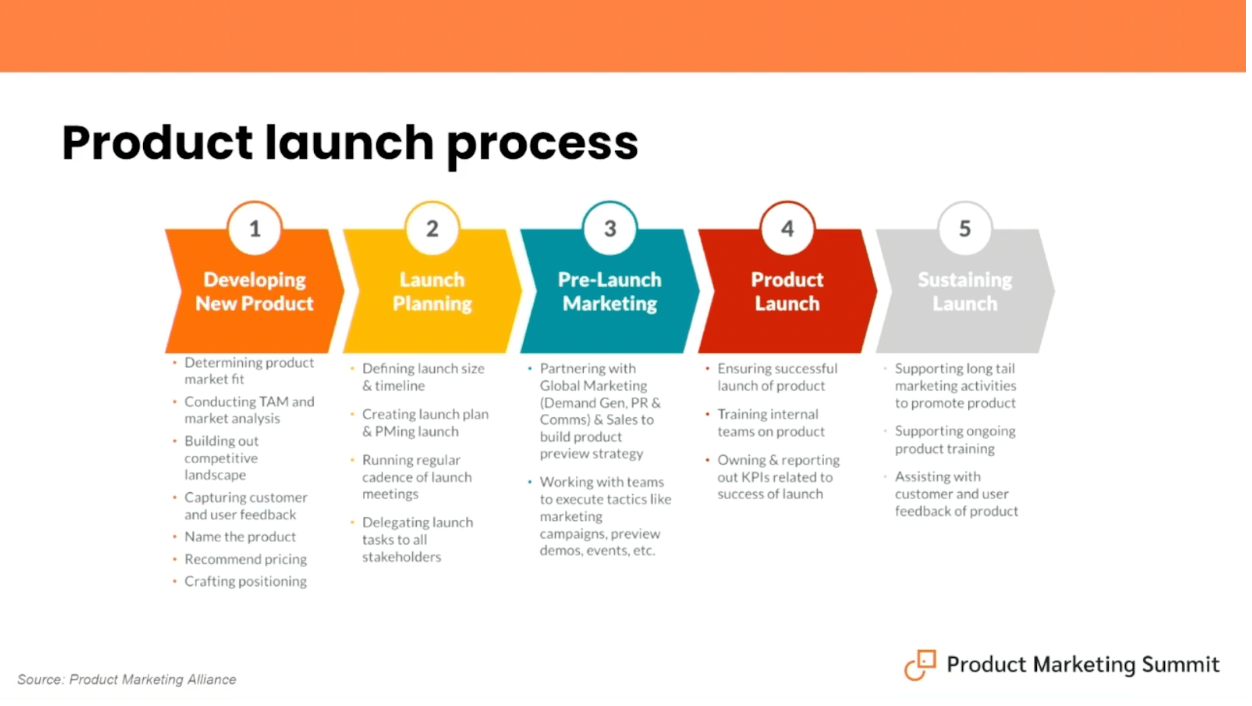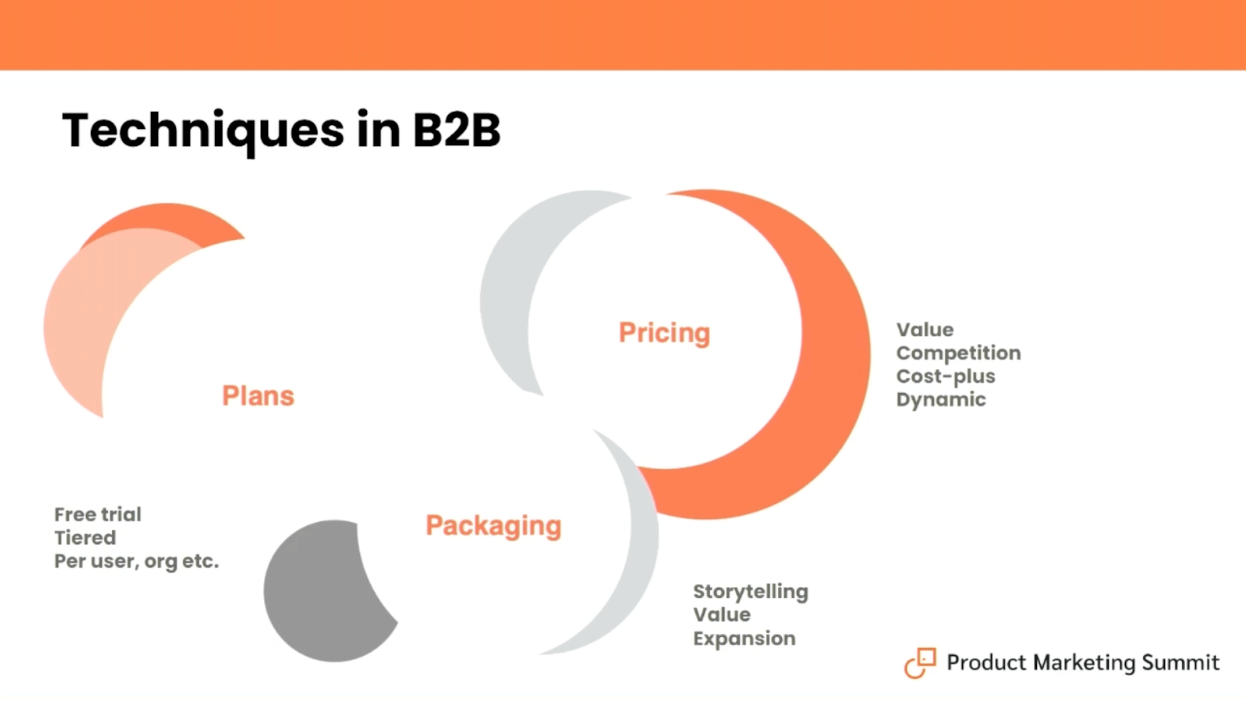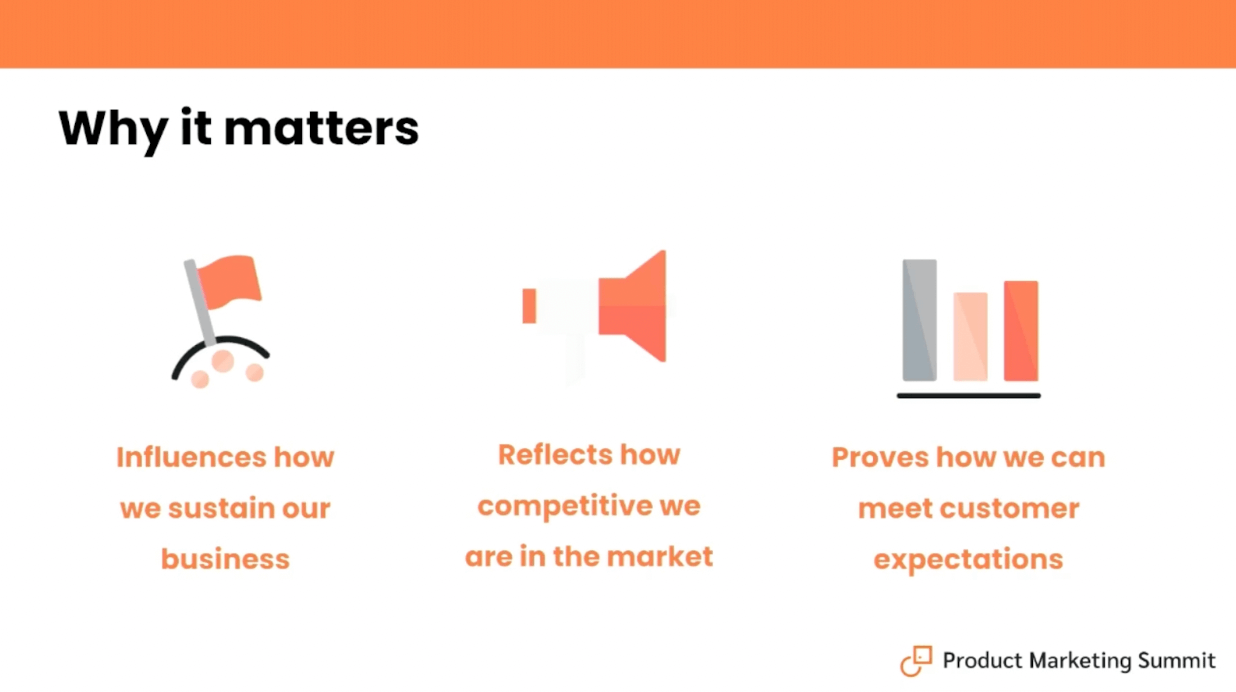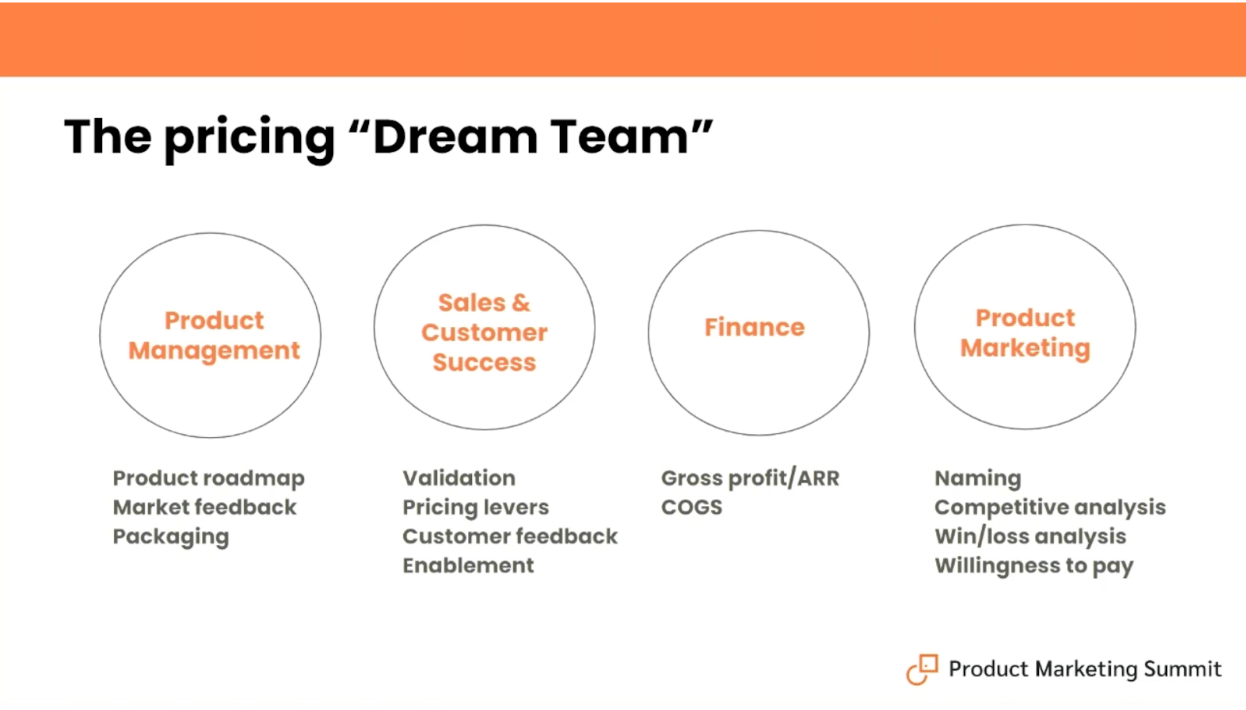Hey there! My name is Andrea Bailiff-Gush, and I’m the Head of Product Marketing at a startup called AppOmni.
I think we all have superpowers as product marketers and my superpower is cross-functional collaboration, which is a big part of what we're going to focus on today as we dive into how to price and package a product, make it a strategic revenue driver in your organization, and get a seat at the table when pricing decisions are being made.

In this article, I'll be focusing on:
- What pricing and packing is
- B2B pricing and plans
- Why product marketing needs to be involved in pricing decisions
- The pricing dream team
- How to build a pricing team
- Pricing team objectives
- How to communication pricing decisions internally
- How to make pricing strategy a strategic revenue driver
What is pricing and packaging?
The Go-to-Market process should be familiar to all of us as product marketers.
First, the product is developed, and we start working on persona research and messaging.
Then we think about the timing of the launch, we size it, we plan a launch event, and we do pre-launch marketing to seed the market.
Then comes the lightning strike moment: the product launch. After that, we move to sustaining the launch and ensuring the enthusiasm it generated doesn’t dip.

So where does the pricing come into this process? We tend to assume that it comes near the end of the process – when we’re working with sales, getting ready for enablement sessions, and thinking about how to put the new product into our CRM.
However, pricing should be part of the first phase of our go-to-market process because it’s an incredibly strategic and important element. It involves thinking about the target audience, use cases for the product, and the problem that the product solves – all of these factors go into how a product is priced and packaged.
B2B pricing and plans
There are a lot of different ways to approach pricing in B2B. Here are a few pricing models you might want to consider:
- Pricing based on value: This involves sitting down with prospects or customers and conducting willingness-to-pay surveys.
- Pricing based on competition: In this approach, you conduct a competitive analysis and determine whether to go higher or lower than your competition.
- Cost-plus pricing: This involves looking at the cost of the product and adding a percentage on top of that to ensure a healthy margin.
- Dynamic pricing: The idea here is that you increase the value of your offering and adjust the cost over time as the customer relationship grows.

There are also a few different ways to approach your plans:
- Free trial: The idea here is to give users access to your product for a short amount of time – just enough for them to see the value – before getting them into a paid plan.
- Tiered: This is the good/better/best or basic/advanced/professional approach. This model can help you build the right packages for different segments, for instance, SMB mid-market, and enterprise.
- Pricing per user: (Or per license, per app, or per organization)
In short, there are all kinds of different strategies and models involved in pricing and packaging. You just need to find the one that’s best for your customer base and your company.

Pricing matters for several reasons. Firstly, it influences how a business will be sustained, keep the lights on, and continue to delight its customers.
Secondly, it impacts how a company is perceived and compared to its competitors. Finally, it proves how a company can meet customer expectations and encourage customer growth over time.
Why product marketing needs to be involved in pricing decisions
In my experience, pricing usually has usually been led by product and sales. Product builds its roadmap and then gets together with sales to think about the price before validating it with customers and prospects.
Then they come to marketing and tell us what the price is going to be and make sure we build that into our go-to-market strategy.
It’s an absolute mess.
Imagine being a customer and coming across positioning and messaging for a product that doesn’t align with its price. Imagine how jarring an experience that would be.
That's why it's so important for product marketers to be involved in pricing decisions. We're perfectly placed to take the target market, competitors, and positioning and messaging into consideration as the decision is being made.
The pricing dream team
Below, I've put together a quick visual of what I call the Pricing Dream Team. It consists of four key perspectives, and I've intentionally arranged them horizontally because each of them contributes equally to pricing decisions.
Let's examine each role and the value they bring to the table.

We’ll start with product management – one of the usual suspects involved in pricing decisions. They define the product roadmap and initiate pricing discussions for new features.
Product managers are also often involved in customer and sales calls, so they can gather valuable market feedback. On top of that, they’re key players in packaging the product and determining how to best bundle different features and functionalities to solve customers' problems.
Sales and customer success are other essential parts of this dream team. They can validate prices with customers, prospects, and sales reps. They’re also thinking about pricing levers, which are strategies or techniques that can be used to close deals.
For example, if reps are struggling to get a deal over the finishing line, they might throw in more seats for free or offer a discount – that’s a pricing lever and you need to consider it in your pricing models.
The second half of the Pricing Dream Team consists of roles you might not generally associate with pricing decisions. There’s finance, which plays a significant part in ensuring the company can cover costs while setting prices.
They’re also responsible for measuring and modeling gross profit and ARR, making sure that the product's pricing is going to help the company meet its financial goals.
Last but not least, product marketers bring their expertise to the table. We’re responsible for naming packages and features and making sure those names are consistent across the product portfolio.
We also conduct competitive analysis, which is crucial for keeping a finger on the pulse of the market and understanding how much competitors are charging – the last thing we want is to launch a product and then have a competitor come out with a much cheaper alternative.
Product marketers also do win-loss analysis, examining new deals and renewals to understand if pricing influenced the outcome. Finally, we assess customers' and prospects' willingness to pay.
This essentially means sitting down with customers and prospects, presenting a feature or doing a demo, and asking what they would be willing to pay for this product or feature.

How to build a pricing team
So how do you form a pricing team? How do you persuade people who are already juggling multiple projects and deadlines to get involved in pricing? It’s a challenge for sure.
To address this challenge, you have to be strategic and use all of your people skills. Take the time to get to know your colleagues and understand their responsibilities. Building relationships and sharing your plans will go a long way to helping you assemble your pricing team.
Another tactic is to start by examining your company's structure. In a startup, it's pretty easy to decide who you want on your pricing team – normally it’s the most experienced or knowledgeable person.
In larger companies, you might need multiple pricing teams for different segments or solutions. No matter what size your company is, forming a strong pricing team takes strategic thinking and people skills.
Pricing team objectives
Okay, so you did an awesome job of recruiting people to your pricing team; now you just need to decide on your objectives.
What value are you going to provide to the organization? Of course, you're supporting profitability for the business. Here are a few ways you’re going to do that:
- Creating a pricing scheme that supports upsell opportunities
- Validating pricing for every new feature and functionality as part of the go-to-market strategy
- Evaluating the current pricing and packaging strategy
How to communicate pricing decisions internally
Now you’ve formed your team and you’ve got some processes in place, it’s time to roll them out internally. You need people to understand that the pricing team plays a strategic role in the company.
If you have regular all-hands meetings in your company, see if you can get on the agenda to introduce your pricing team, share how you can help each team solve their problems, and make sure everyone knows that all pricing decisions have to come through your team.
You’ll also need to be sure to create ongoing feedback loops between your pricing team and other teams.
To get buy-in, you have to recruit an executive sponsor. Typically, that's your boss. I report to the CMO, so that’s my executive sponsor.
If you meet weekly as a pricing team, you should meet monthly with your executive sponsor to present your pricing recommendations and get an agreement from them. You'll also want to show any analysis on pricing and packaging decisions and recommendations and tie them to the company's objectives.

How to make pricing strategy a strategic revenue driver
So, how can you make sure that your pricing strategy moves the needle for your business?
First, you need to incorporate pricing into your go-to-market process; it should come into the first phase.
Throughout this process, make sure you lead with data by conducting willingness-to-pay surveys and analyzing customer feedback to understand their pain points and needs. Next, think about how to package your product. That’s going to help determine your price point.
Pricing is not static, so it’s essential to reevaluate your pricing regularly. After launching a product, I always ask our revenue operations team to create a dashboard in Salesforce that I can use to track new deals, revenue contributions, and other relevant metrics. This is the kind of information you want to be able to show your boss.
It’s also a good idea to create a pricing roadmap that aligns with your product and marketing roadmaps. This is going to help you plan for upcoming features and functionalities and it’s going to allow you to schedule reevaluations of your current packaging and pricing structures.
As you do all this, it’s vital to consider the impact of pricing decisions on other teams and ensure that they have enough time to implement any changes.
Typically, revenue operations and enablement teams are going to be most affected. Be sure to provide them with all the necessary information upfront and coordinate with their list of responsibilities.
Contracts are also crucial to consider, especially when you’re changing a package or plan. Think about customers approaching renewals or opportunities in the final sales stages and how any drastic changes might affect them.
Additionally, don't forget to update your website if you have pricing information displayed there. Finally, invest in training to ensure your sales reps fully understand any new pricing models or features and how they are priced.
By giving due consideration to these factors, you’ll create a more seamless process for pricing decisions, ultimately leading to a more effective pricing strategy that benefits both your organization and your customers.

Final thoughts
If you remember anything from this article, make it these points:
- Harness the power of the Pricing Dream Team – product marketing, sales, and finance.
- Consider pricing from the moment of the product’s inception, not as an afterthought right before your launch event.
- Be aware of what competitors are charging.
- Make sure you run willingness-to-pay surveys.
- Cover your costs.
- Gain the support of executive sponsors and the leadership team.
- Consider how any pricing updates will affect other teams.
- Remember to update your sales tools.
- Pricing is a living breathing thing so continue to evaluate and optimize.






